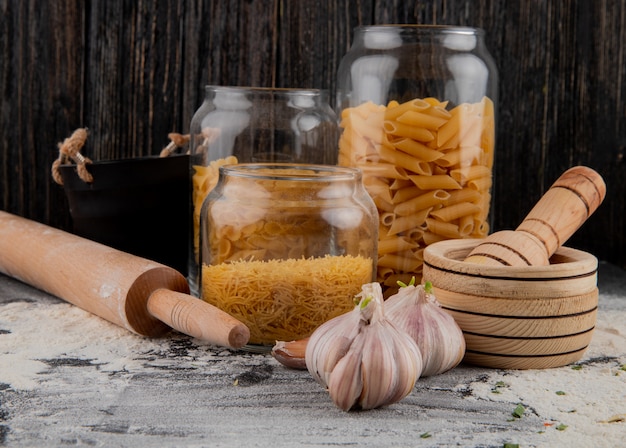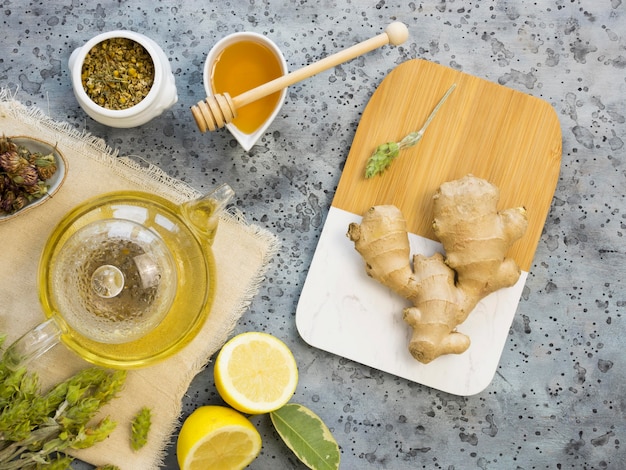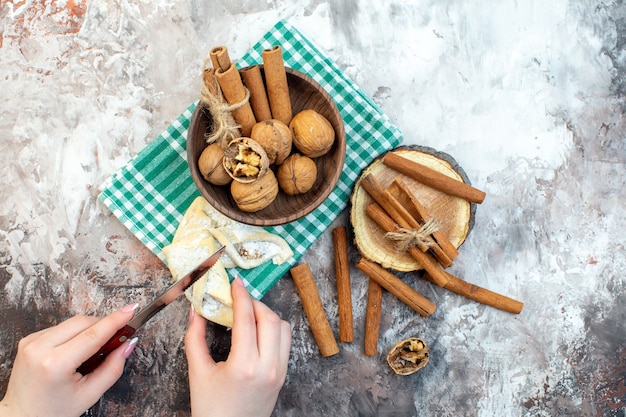Ginger. It's one of those ingredients that's both incredibly versatile and utterly captivating. It can be a subtle background note in a sweet, creamy dessert or a vibrant, fiery star in a spicy stir-fry. And, let me tell you, I've been on a bit of a ginger obsession lately. I find myself adding it to everything, from my morning smoothie to my evening curry. It's that kind of ingredient that just makes you want to experiment and see what kind of magic you can create.
So, I thought, why not share this ginger love with you? In this guide, we're going on a culinary adventure together. We'll explore the different types of ginger, delve into its health benefits, and learn some essential tips and techniques. We'll also uncover the rich history and cultural significance of ginger across the globe. And, of course, we'll be whipping up some delicious recipes – from classic ginger snaps to exotic Thai curries. Get ready, folks, because ginger is about to become your new culinary best friend!
(Part 1) Unveiling the Wonders of Ginger

Types of Ginger: More Than Just One
You might be surprised to learn that there are actually a few different types of ginger out there. While we all know the standard ginger we find in our local supermarkets, there are some lesser-known varieties that deserve a little love. Each type brings its own unique flavour and texture to the table, offering a world of culinary possibilities.
- Young Ginger: This is the more delicate version, often harvested before the root has fully matured. It has a milder flavour and a slightly peppery kick, almost like a spring onion. Young ginger is often used in Asian cuisine, particularly in stir-fries and salads, where its crisp texture and subtle flavour enhance the overall dish.
- Mature Ginger: This is the ginger we're most familiar with. It has a stronger, more pungent flavour, with earthy and slightly sweet notes, and is perfect for adding depth and warmth to both sweet and savoury dishes.
- Preserved Ginger: This ginger is a fascinating twist on the traditional root. It's been simmered in a sweet and sour brine, giving it a tangy and slightly spicy flavour. Preserved ginger is often used in Chinese cooking, adding a unique touch to stir-fries, noodle dishes, and even desserts. It’s also a delicious snack on its own.
- Black Ginger: This unique variety has a smoky, earthy flavour that is quite distinct from the other types. Black ginger is often used in Southeast Asian cuisine, adding a complex dimension to curries and stir-fries. It also boasts a beautiful black colour that makes it visually appealing.
The Health Benefits of Ginger: A Natural Remedy
Ginger has been celebrated for its medicinal properties for centuries. It's a natural anti-inflammatory, and it’s been shown to help soothe nausea, reduce muscle soreness, and even boost the immune system. But it's not just about its health benefits; there's something about the warm, comforting flavour of ginger that just makes you feel good. It's like a natural mood booster, bringing a sense of calm and well-being.
Choosing the Perfect Ginger: Getting It Right
To get the most out of your ginger, you need to choose it wisely. Here's what to look for:
- Firm and Smooth: Avoid ginger that is soft or shriveled. Look for ginger that has a firm, smooth skin and a fresh scent. This indicates that the ginger is still full of moisture and flavour.
- Avoid Bruising: Try to pick ginger that is free of bruises or blemishes. These areas can harbour bacteria and affect the flavour. A good rule of thumb is to choose ginger with a vibrant, even colour.
- Store it Properly: Ginger can last for weeks if stored properly. Keep it in a cool, dry place, wrapped in a paper towel or plastic bag. This will help to prevent moisture loss and maintain its flavour.
(Part 2) Unleashing the Ginger Flavour

Ginger Preparation: From Root to Recipe
The fun starts here! Preparing ginger can seem intimidating, but trust me, it's actually quite simple. Once you get the hang of it, you'll be chopping and grating ginger like a pro in no time.
For simple dishes, like stir-fries, you can just slice the ginger into thin pieces. This will allow the ginger to infuse the dish with its flavour without overpowering other ingredients. But for recipes that require a more intense flavour, you'll want to grate or mince the ginger. Here's a little trick I've learned over the years: Use a microplane grater. It creates a really fine texture that will infuse your dish with the full potential of the ginger flavour. I swear, you can practically smell the ginger magic happening in the air!
A Note on Ginger's Bite: Finding the Right Balance
Ginger, especially fresh ginger, has a powerful flavour. It’s all about balancing that powerful flavour. If you're new to ginger or prefer a milder taste, you can start with a small amount. Remember, you can always add more, but you can't take it away! If you're unsure, start with a small amount and taste as you go.
Unlocking the Aromatic Potential: A Trick for Deeper Flavour
To really unlock ginger's aromatic power, try toasting it lightly in a pan before adding it to your dish. This will intensify the flavour and release those wonderful spicy notes. Just make sure you don't burn it. A touch of browning is all it takes! You'll be surprised at how much deeper and more complex the flavour becomes.
(Part 3) Ginger in the Kitchen: A Culinary Playground

Ginger in Sweet Treats: A Surprisingly Versatile Ingredient
Don't be fooled by its spiciness; ginger has a surprisingly sweet side. It's a wonderful addition to desserts, adding a warm, complex flavour that elevates any treat. The subtle heat of ginger complements the sweetness of desserts beautifully, creating a harmonious balance of flavours.
Here are a few ginger-infused sweet delights I love to make:
- Ginger Snaps: These classic cookies are crisp and chewy, with a delightful ginger kick. They’re perfect for a cozy afternoon tea or a festive holiday treat. I like to add a sprinkle of sea salt to enhance the ginger flavour.
- Gingerbread: This holiday favourite is a true testament to ginger's magic. The spice blends perfectly with the molasses and spices for a truly comforting treat. There’s something about the warm aroma of gingerbread that instantly evokes a sense of holiday cheer.
- Ginger Ice Cream: A refreshing and flavourful twist on the classic ice cream. It's perfect on a hot day, offering a cool and spicy treat that’s both refreshing and satisfying. You can even add a touch of candied ginger for extra texture and flavour.
Ginger in Savoury Dishes: A Global Star
Ginger is a true chameleon in the culinary world, shining just as brightly in savoury dishes as it does in sweet ones. It’s a versatile ingredient that can be used to add depth, warmth, and a touch of spice to a wide range of cuisines.
Here are some savoury recipes that I can’t get enough of:
- Stir-fries: Ginger is a staple in Asian cuisine, adding a vibrant, spicy flavour to stir-fries. Combine it with other aromatic ingredients like garlic and chilli, and you've got a symphony of flavours. I love adding a splash of soy sauce or fish sauce for extra depth. The combination of ginger, garlic, and chilli is truly magical.
- Thai Curry: Ginger is a key ingredient in many Thai curries, lending a spicy and earthy flavour. I particularly love green curry with its creamy coconut milk base and fiery ginger kick. The heat of ginger complements the creamy richness of the coconut milk beautifully, creating a complex and satisfying curry.
- Ginger-Garlic Sauce: This sauce is a fantastic accompaniment to fish, chicken, and vegetables. It's so easy to make and adds a burst of flavour to any dish. The combination of ginger and garlic is a classic pairing that’s both simple and incredibly versatile.
(Part 4) Ginger Recipes: From Classic to Creative
Ginger Snaps: A Classic Treat
Ingredients:
- 1 cup (2 sticks) unsalted butter, softened
- 1/2 cup granulated sugar
- 1/2 cup packed brown sugar
- 1 teaspoon ground ginger
- 1/2 teaspoon ground cinnamon
- 1/4 teaspoon ground cloves
- 1/2 teaspoon baking soda
- 1/4 teaspoon salt
- 2 1/4 cups all-purpose flour
Instructions:
- Preheat oven to 350 degrees F (175 degrees C).
- In a large bowl, cream together butter and sugars until light and fluffy. Beat in the ginger, cinnamon, cloves, baking soda, and salt. Make sure to beat the ingredients thoroughly to ensure a well-combined dough.
- Gradually add flour until dough comes together. Chill for at least 1 hour. This will allow the dough to firm up and make it easier to work with.
- Roll dough into 1-inch balls. Place on ungreased baking sheets. Flatten slightly with a fork. The fork creates a beautiful criss-cross pattern on top of the cookies, adding a touch of elegance.
- Bake for 8-10 minutes, or until edges are lightly golden brown. Keep a close eye on the cookies as they bake, as they can burn quickly.
- Let cool on baking sheets for a few minutes before transferring to a wire rack to cool completely. This will prevent the cookies from becoming soggy.
Spicy Ginger-Garlic Sauce: A Burst of Flavour
Ingredients:
- 1/2 cup soy sauce
- 1/4 cup rice vinegar
- 1/4 cup water
- 2 tablespoons grated ginger
- 2 tablespoons minced garlic
- 1 tablespoon honey
- 1 teaspoon sesame oil
- 1/2 teaspoon red pepper flakes
Instructions:
- In a small bowl, whisk together all ingredients until well combined. The sauce should be smooth and homogenous.
- Let sauce sit for at least 30 minutes to allow flavours to develop. This will allow the flavours to meld and create a more complex and delicious sauce.
- Serve over chicken, fish, or vegetables. Or, enjoy it as a dip with spring rolls or dumplings. I love using it in wraps! It's a versatile sauce that can be used in a variety of ways.
(Part 5) Beyond the Recipe: Ginger in Everyday Life
Ginger Tea for a Boost: A Warm and Soothing Comfort
On a chilly day, there’s nothing quite like a cup of ginger tea. It’s warm, soothing, and has a wonderfully refreshing flavour. It’s a bit of a ritual for me. I steep a couple of slices of fresh ginger in hot water for about 10 minutes, then add a squeeze of lemon and a touch of honey for sweetness. It's like a hug from the inside out.
Ginger for a Refreshing Bath: A Sensory Delight
Ginger isn't just for the kitchen. You can also use it in the bath! Add a few slices of ginger to your bathwater for a relaxing and invigorating experience. The warm, spicy scent will fill the bathroom and leave you feeling refreshed. You can also add a few drops of ginger essential oil to enhance the aroma.
Ginger in Natural Remedies: A Centuries-Old Practice
Ginger has been used for centuries as a natural remedy. You can make your own ginger paste by grinding up fresh ginger and mixing it with water. Apply this paste to your skin to help relieve muscle soreness or to soothe a cough. Ginger has also been known to aid digestion and reduce nausea. However, it’s always a good idea to consult with a healthcare professional before using ginger for medicinal purposes.
(Part 6) The Magic of Ginger: A Personal Reflection
For me, ginger is more than just an ingredient. It's a reminder of the magic that can be found in the simplest things. It's about taking the time to appreciate the flavours and aromas that surround us, and finding ways to incorporate them into our lives. It's about the joy of experimenting in the kitchen and creating something delicious that brings us and those around us a bit of happiness. Ginger has a way of inspiring creativity and bringing people together.
So, what are you waiting for? Embrace the magic of ginger. Give these recipes a try. Experiment with different ways to use it. And most importantly, have fun! The culinary world of ginger is vast and exciting, so let your imagination run wild and discover your own ginger magic.
(Part 7) Ginger in Other Cultures: A Global Perspective
Ginger in Chinese Cuisine: A Culinary Staple
In Chinese cuisine, ginger is a staple ingredient, used in both sweet and savoury dishes. It is often combined with garlic, scallions, and soy sauce to create a complex and flavourful sauce. This combination of ginger, garlic, and soy sauce is a classic pairing in Chinese cuisine, adding depth and umami to stir-fries, noodle dishes, and braised meats. Ginger is also used in Chinese medicine to treat various ailments. It is believed to have warming properties that can help to alleviate chills and boost circulation. In Chinese medicine, ginger is often used in teas and tonics to promote well-being.
Ginger in Indian Cuisine: A Spice with Depth
Ginger is a fundamental ingredient in Indian cuisine, adding a spicy and aromatic touch to many dishes. It is often used in curries, stir-fries, and chutneys. Ginger is also a key ingredient in many Indian pickles and preserves. The combination of ginger with other Indian spices, such as turmeric, cumin, and coriander, creates a symphony of flavours that are both complex and comforting. Ginger is also used in Indian medicine to aid digestion and reduce inflammation.
Ginger in Japanese Cuisine: A Versatile Ingredient
In Japanese cuisine, ginger is used in a variety of dishes, from sushi to tempura. It is often grated and served as a condiment, or used to flavour marinades and sauces. Ginger is also used in Japanese medicine to treat nausea, motion sickness, and indigestion. The Japanese have a deep respect for ginger, using it in both culinary and medicinal practices. Ginger is a common ingredient in Japanese pickles, as well as in traditional Japanese sweets.
Ginger in Southeast Asian Cuisine: A Flavorful Star
Ginger is widely used in Southeast Asian cuisine, adding a vibrant and spicy flavour to many dishes. It is often combined with lemongrass, chillies, and other aromatic ingredients to create complex and flavourful curries, soups, and stir-fries. Ginger is also used in many Southeast Asian pickles and preserves. The combination of ginger, lemongrass, and chillies is a classic flavour profile in Southeast Asian cuisine, creating a symphony of spicy, citrusy, and grassy notes. Ginger is also used in Southeast Asian medicine to treat a variety of ailments, including colds and flu.
(Part 8) FAQs: Your Ginger Questions Answered
Q: How do I know if ginger is fresh?
A: Fresh ginger should feel firm to the touch, have a smooth, unblemished skin, and a strong, aromatic scent. If the ginger feels soft, shriveled, or smells stale, it's likely past its prime. A good trick is to gently squeeze the ginger; it should spring back to its original shape.
Q: Can I substitute ground ginger for fresh ginger?
A: While you can substitute ground ginger for fresh, keep in mind that the flavour will be less intense. As a general rule, use about 1/2 teaspoon of ground ginger for every tablespoon of fresh ginger. This is because ground ginger has already been dried and processed, resulting in a more concentrated flavour.
Q: What are some good substitutes for ginger?
A: If you don't have ginger on hand, you can try substituting with other aromatic ingredients, such as galangal (similar to ginger but with a more citrusy flavour), lemongrass (has a citrusy and grassy flavour), or turmeric (has a warm, earthy flavour). However, these substitutes will not provide the same exact flavour as ginger.
Q: How long does ginger last?
A: Fresh ginger can last for several weeks if stored properly. Store it in a cool, dry place, wrapped in a paper towel or plastic bag. You can also freeze ginger for up to 6 months. To freeze ginger, simply peel and slice it, then place it in a freezer-safe bag. Frozen ginger can be grated directly from the bag.
Q: Can I eat ginger skin?
A: The skin of ginger is quite tough and fibrous, so it's best to peel it before using. However, if you're using ginger for a tea or a broth, you can leave the skin on, as it will add a more intense flavour. The skin is also rich in antioxidants. Just remember to wash the ginger thoroughly before using it.
I hope this guide has inspired you to explore the world of ginger. It's a versatile ingredient that can bring a unique and delicious flavour to your dishes, and its health benefits make it a welcome addition to any kitchen. So, get cooking, and let your taste buds experience the magic of ginger!
Everyone is watching

How to Cook Frozen Lobster Tails Perfectly: A Step-by-Step Guide
RecipesLobster. Just the word conjures up images of lavish meals, special occasions, and a taste of luxury. But let's...

Pigs in a Blanket Cooking Time: How Long to Bake for Perfect Results
RecipesAh, pigs in a blanket. Just the name conjures up images of those delightful little parcels of crispy pastry en...

Pork Fillet Cooking Time: How Long to Cook It Perfectly
RecipesPork fillet, or tenderloin as it's sometimes called, is a real favourite in our house. It's so versatile, and...

The Ultimate Guide to Cooking Sweet Potatoes: From Roasting to Mashing
RecipesSweet potatoes. Just the name conjures up images of warm, comforting dishes, bursts of vibrant color, and a to...

The Ultimate Guide to Tender, Juicy Pulled Pork
RecipesRight, let's talk pulled pork. It's one of those dishes that just screams "comfort food," doesn't it? I mean...
